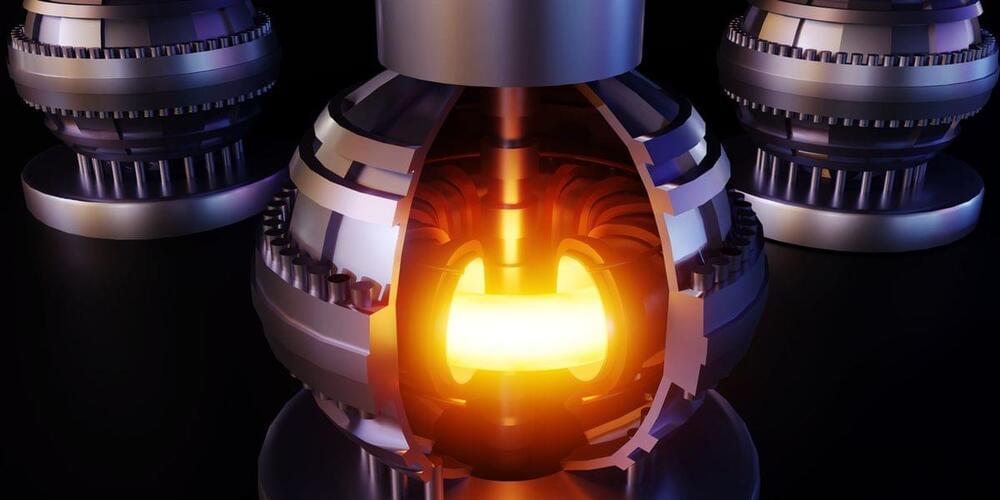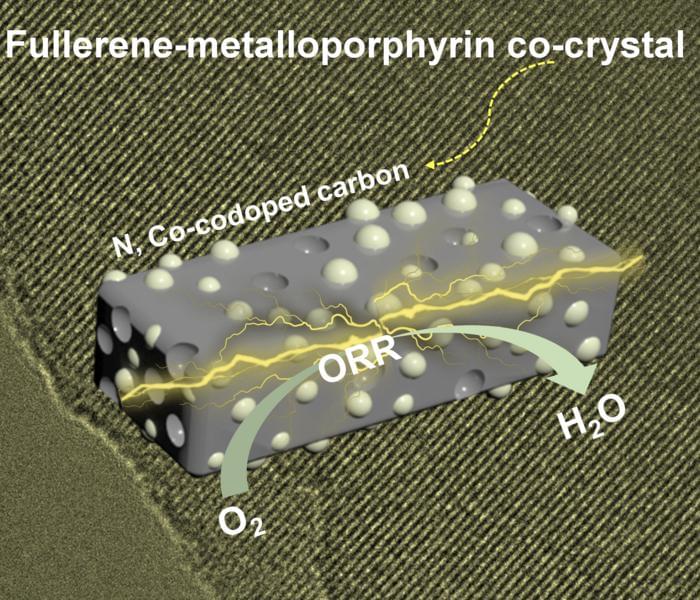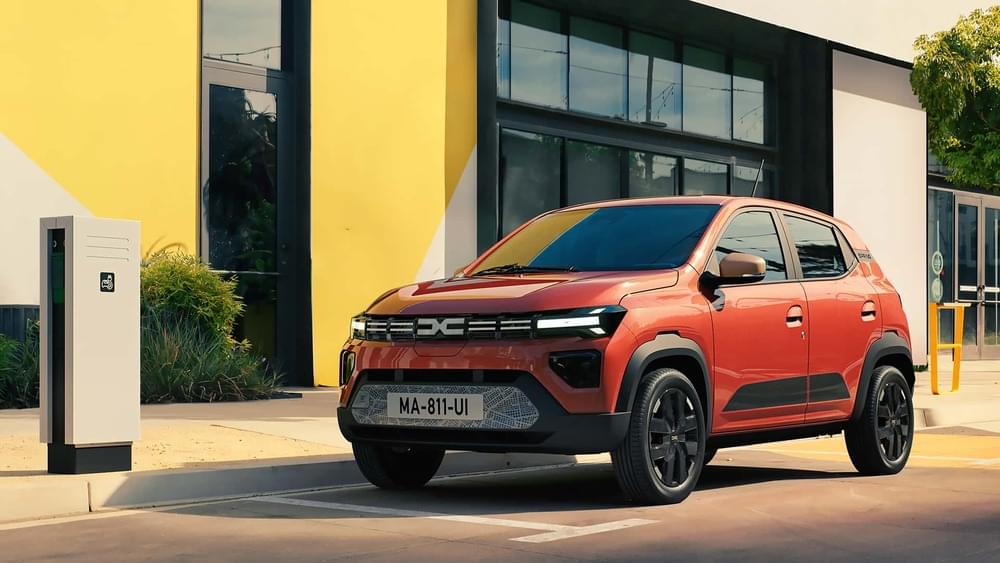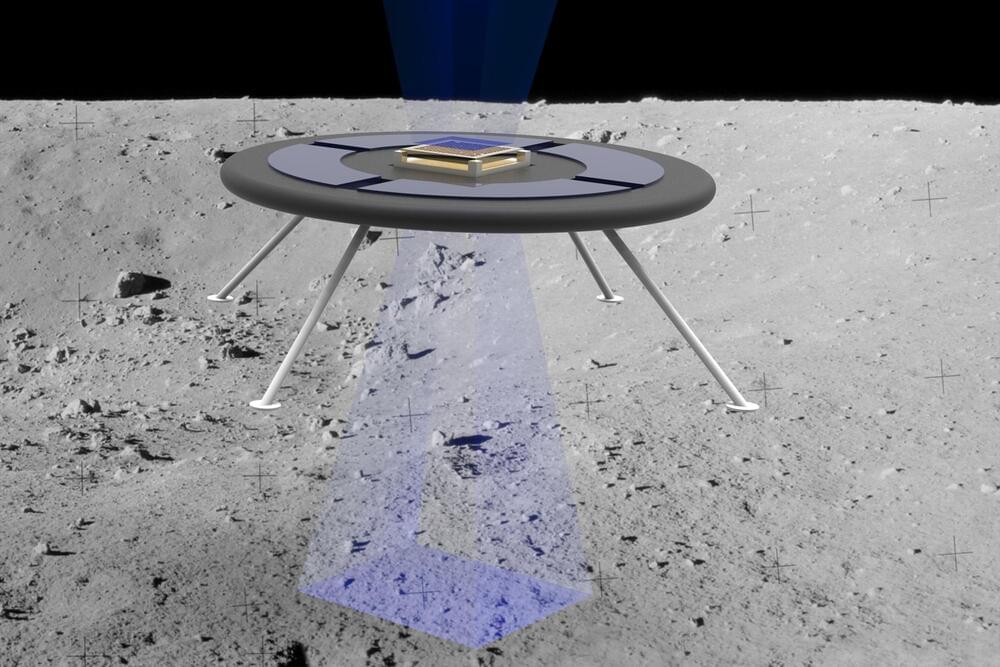Archive for the ‘energy’ category: Page 50
Feb 29, 2024
Supramolecule combination of fullerene and metalloporphyrin improves zinc-air battery function
Posted by Omuterema Akhahenda in categories: energy, sustainability, transportation
Zinc-air batteries are an inexpensive, powerful battery alternative that can be used on the small scale to power electronics or on the large scale for electric vehicles or energy storage. These batteries work when oxygen from the air oxidizes zinc, but the difficulty in oxygen activation which degrades battery performance has prevented their wide commercial adoption.
Information presented in a paper published in Carbon Future (“Fullerene-metalloporphyrin co-crystal as efficient ORR electrocatalyst precursor for Zn-air batteries”) shows how the addition of fullerene-derived carbon materials as catalysts can improve performance, stability, and cost of zinc-air batteries.
This graphic illustrates a zinc-air battery can using a fullerene-metalloporphyrin co-crystal as an oxygen reduction reaction catalyst. (Image: Carbon Future, Tsinghua University Press)
Feb 28, 2024
Nonreciprocal Frustration Meets Geometrical Frustration
Posted by Saúl Morales Rodriguéz in categories: education, energy, mathematics, physics
New theoretical work establishes an analogy between systems that are dynamically frustrated, such as glasses, and thermodynamic systems whose members have conflicting goals, such as predator–prey ecosystems.
A system is geometrically frustrated when its members cannot find a configuration that simultaneously minimizes all their interaction energies, as is the case for a two-dimensional antiferromagnet on a triangular lattice. A nonreciprocal system is one whose members have conflicting, asymmetric goals, as exemplified by an ecosystem of predators and prey. New work by Ryo Hanai of Kyoto University, Japan, has identified a powerful mathematical analogy between those two types of dynamical systems [1]. Nonreciprocity alters collective behavior, yet its technological potential is largely untapped. The new link to geometrical frustration will open new prospects for applications.
To appreciate Hanai’s feat, consider how different geometric frustration and nonreciprocity appear at first. Frustration defies the approach that physics students are taught in their introductory classes, based on looking at the world through Hamiltonian dynamics. In this approach, energy is to be minimized and states of matter characterized by their degree of order. Some of the most notable accomplishments in statistical physics have entailed describing changes between states—that is, phase transitions. Glasses challenge that framework. These are systems whose interactions are so spatially frustrated that they cannot find an equilibrium spatial order. But they can find an order that’s “frozen” in time. Even at a nonzero temperature, everything is stuck—and not just in one state. Many different configurations coexist whose energies are nearly the same.
Feb 28, 2024
Unlocking the Mysteries of Rainfall With FY-3G, Earth’s New Eye in the Sky
Posted by Saúl Morales Rodriguéz in categories: chemistry, energy, satellites
Measuring the precise quantity of rainfall in a particular area is straightforward when there is equipment specifically designed to accurately capture and relay precipitation data. However, quantifying and identifying the types of precipitation across all locations on Earth presents significant logistical challenges.
Importantly, this information could provide a wealth of data for characterizing and predicting Earth’s water, energy, and biogeochemical cycles. Researchers from China recently deployed a satellite, FengYun 3G (FY-3G), that is successfully collecting Earth precipitation data from space.
Feb 27, 2024
Algorithms are everywhere
Posted by Gemechu Taye in categories: education, energy, information science, internet
Chayka argues that cultivating our own personal taste is important, not because one form of culture is demonstrably better than another, but because that slow and deliberate process is part of how we develop our own identity and sense of self. Take that away, and you really do become the person the algorithm thinks you are.
As Chayka points out in Filterworld, algorithms “can feel like a force that only began to exist … in the era of social networks” when in fact they have “a history and legacy that has slowly formed over centuries, long before the Internet existed.” So how exactly did we arrive at this moment of algorithmic omnipresence? How did these recommendation machines come to dominate and shape nearly every aspect of our online and (increasingly) our offline lives? Even more important, how did we ourselves become the data that fuels them?
These are some of the questions Chris Wiggins and Matthew L. Jones set out to answer in How Data Happened: A History from the Age of Reason to the Age of Algorithms. Wiggins is a professor of applied mathematics and systems biology at Columbia University. He’s also the New York Times’ chief data scientist. Jones is now a professor of history at Princeton. Until recently, they both taught an undergrad course at Columbia, which served as the basis for the book.
Feb 26, 2024
New Research Shows That Something Strange Is Going On in the Butterfly Nebula
Posted by Shubham Ghosh Roy in categories: energy, materials
When red giant stars run out of helium fuel and expel their outer layers to become hot, compact white dwarf stars that are roughly the size of Earth, planetary nebulae are created. As the carbon-enriched shed material is gradually blasted into the interstellar medium, it produces magnificent patterns.
The majority of planetary nebulae are circular, but others, like the well-known “Butterfly Nebula,” have an hourglass or wing-like appearance. These structures are thought to be the consequence of the material expanding into two lobes or “wings” due to the gravitational attraction of a second star circling the parent star of the nebula. The wings develop over time without altering their initial form, much like an expanding balloon.
Feb 25, 2024
Tesla has reached 600,000 worldwide Powerwall installations
Posted by Shailesh Prasad in category: energy
Tesla has reached a new milestone with the installation of its Powerwall energy storage systems around the world, just as the company starts rolling out its next-generation version of the system in the U.S.
Feb 25, 2024
The Super-Cheap Dacia Spring EV Can Now Power Your Appliances Too
Posted by Shailesh Prasad in category: energy
The Chinese-made urban runabout can export up to 3.5 kilowatts of power from its 27-kilowatt-hour battery pack.
Feb 24, 2024
MIT engineers test an idea for a new hovering rover
Posted by Quinn Sena in categories: energy, space
Year 2021 face_with_colon_three
Because they lack an atmosphere, the moon and other airless bodies such as asteroids can build up an electric field through direct exposure to the sun and surrounding plasma. On the moon, this surface charge is strong enough to levitate dust more than 1 meter above the ground, much the way static electricity can cause a person’s hair to stand on end.
Engineers at NASA and elsewhere have recently proposed harnessing this natural surface charge to levitate a glider with wings made of Mylar, a material that naturally holds the same charge as surfaces on airless bodies. They reasoned that the similarly charged surfaces should repel each other, with a force that lofts the glider off the ground. But such a design would likely be limited to small asteroids, as larger planetary bodies would have a stronger, counteracting gravitational pull.
Continue reading “MIT engineers test an idea for a new hovering rover” »
Feb 24, 2024
MIT Scientists May Have Found a Cheap Way of Storing Huge Amounts of Energy in Cement
Posted by Kelvin Dafiaghor in categories: energy, sustainability, transportation
A team of MIT researchers has figured out a way to create a supercapacitor simply by mixing cement, the binding ingredient of concrete, and a fine charcoal product called carbon black together with water.
Better yet, this mixture could allow a home to store a full day’s worth of energy in its foundation, potentially paving the way to an efficient renewable energy storage solution that doesn’t rely on mining rare Earth metals.
Roads made up of the material could even power electric cars wirelessly, the researchers say, or windmills could store their generated energy in their base.


















